EWP Option Strategies – Part 2
EWP Option Strategies – Part 2
Alright, Evil Rat Academy is now officially in session – everyone please return to their desks – BobbyLow, stop chewing gum and blowing paper bullets at Tronacate. Tradingmon – stop that fire in the trash can!

It’s Friday and thus time for the 2nd part in our ongoing EWI sponsored series on option strategies. The following post is excerpted from the Elliott Wave International (EWI) eBook, “How to Use the Elliott Wave Principle to Improve Your Options Trading Strategies — Vertical Spreads.” EWI has agreed to make the full eBook available for free to all Evil Speculator readers until the conclusion of this series. So go ahead and download it here if you want to study ahead – however I would appreciate it if we kept all discussions limited to the current chaper.
Last week we introduced the concept of debit spreads and appropriate stages in the wave count at which to trade them. If you missed the chapter then I strongly recommend you go back and study it before continuing here.
Now it’s time to see an example of how to use these strategies on an actual price chart.

Figure 4
This is a futures weekly continuation bar chart of the euro against the U.S. dollar from 2005 to 2008. I’ve labeled the chart starting from the November 18, 2005, weekly low at $1.1661. From there, I’ve counted completed Intermediate waves (1) and (2), and a partial Intermediate wave (3). Intermediate wave (3) sub-divides into Minor waves 1 and 2 (in red) and Minor wave 3 (not labeled on chart) subdivides into Minute waves 6 through 9 (circled in brown). That leaves us with an open ticket into Minute wave 0, so let’s blow up that leg of the advance.
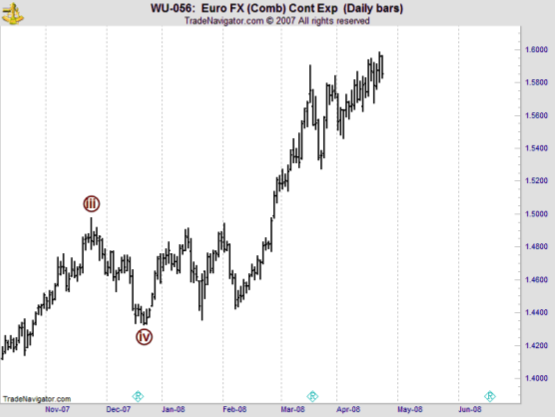
Figure 5
We’re going to start trading on April 23, 2008, the last bar on the daily chart. This will be our entry point.

Figure 6
Now I’ve attached some wave labels, and you can see we have a decisive move up in Minuette waves (i), (ii), and (iii) (in blue). Within Minuette wave (iii), I’m counting Subminuette waves i through v (in red) as one probable scenario. This brings us to the exciting part: Subminuette wave v contains five overlapping waves (circled numbers) with a wedge shape, the classic trait of a fifth-wave ending diagonal. This is an exciting event, because fifth-wave diagonals qualify as one of the key patterns that signal a swift and sharp reversal ahead. And, according to Elliott wave guidelines, the reversal will end at least where the diagonal began. In this case, that area is marked by the start of Subminuette wave iv (in red).
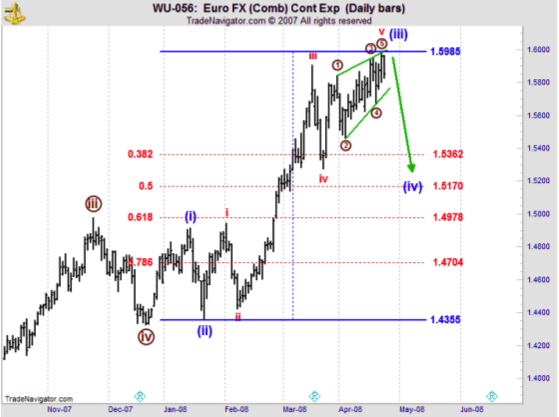
Figure 7
So, what are we looking for? A sharp albeit limited decline for Minuette wave (iv) back to at least the start of the diagonal, and maybe even further beyond that. What if we’re wrong? Are there other possibilities? Yes, the ending fifth-wave diagonal scenario may instead be waves A and B of some type of flat structure. Even so, in a flat, wave C should still come down to where wave B began — a similar target zone as the diagonal scenario. In either case, the larger implication is the same – a move down. The one difference is time. If an ending diagonal is at hand, the decline will be swift; if it’s a flat structure, the drop may take longer to unfold.
Figure 8
Another way to determine how far wave (iv) may go is to look at the market from a Fibonacci retracement point of view. Keep in mind that fourth waves are normally shallow and make .382 retracements. You can see in Figure 8 that the .382 area lands at $1.5362, within winking distance of the level where the diagonal began — $1.5273. Pretty close. Of course, wave (iv) could go further, in which case I’ve also labeled the three common runner-ups for Fibonacci retracement levels: .500, .618, and .786. However, since fourth waves can never end in the price territory of first waves, we can eliminate the .786 scenario.
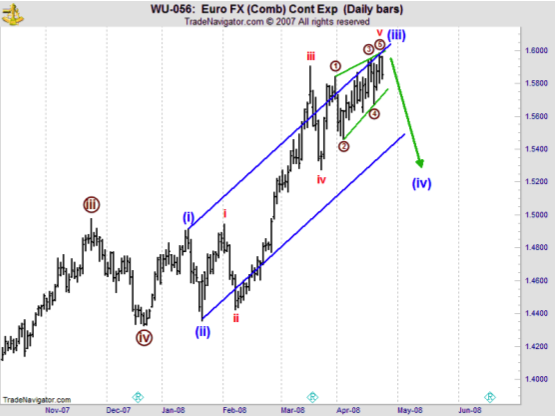
Figure 9
On this chart, drawing a trend channel doesn’t help in terms of price, but it does offer us a guide in terms of time. It calls attention to the fact that we’re looking for a move that could happen fairly soon. Therefore, we don’t have to go out too far with respect to option expiration dates. We don’t have to go out six months, or even three months, to realize the same move. Keep in mind, we want to maximize yield or return on capital. The less money we spend by being able to select a shorter time period for our expiration date, the greater our return on capital will be if we can still achieve the same move within that time period.

Figure 10
Ideally, we’ll hit the nail on the head here. However, Elliott wave analysis is about probabilities, which are never accurate 100% of the time. So, the last thing we need to do is prepare for a Plan B exit strategy, in case we’re wrong and the euro goes up. In Figure 10, I use the Fibonacci guideline of expansion for fifth waves to determine where one should get out to salvage this trade. According to this guideline, one possible scenario is wave five will be equal to .618 times the net distance traveled of waves one through three. And that comes up to $1.6230. So, if prices do go the opposite way and we have a net debit, that’s the one level to keep in mind to unwind the trade and recover whatever we can in terms of premium.
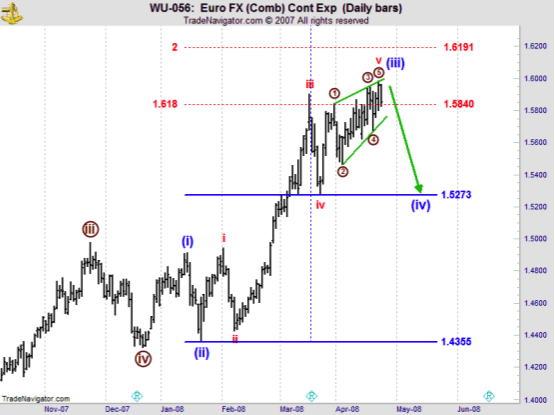
Figure 11
Another useful guideline of Fibonacci analysis states that wave four often divides an entire impulse wave into either the Golden Section or two equal parts. On the chart, you can see that there’s a Golden Section if Sub-minuette wave v (red) ends at $1.5840. (We’ve already gone past that level.) The 50% divider comes out to $1.6191. So, if we’re wrong, this offers another possible area for wave v to travel. In terms of unwinding these trades, we’ll look around that $1.6200 level to warrant getting out of these positions.
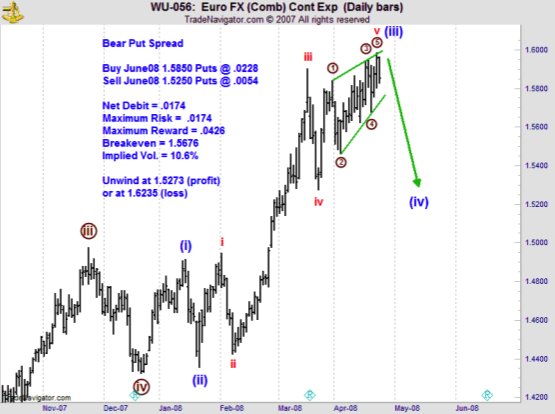
Figure 12
So, now that we have all the pieces in place, let’s examine the big picture. We’re going to do a bear put spread on April 23 (recall Figure 5). On that day, the price high was $1.5964, the low $1.5826, and the close $1.5854. Please Note: All of the option prices that I’m showing are closes. On our entry point of April 23, we’re buying an at-the-money June $1.5850 put at .0228. The June puts expire on June 6th, so we’re keeping this short, just about a month and a half. Next, we’re going to sell an out-of- the-money June $1.5250 put at .0054. And why did I pick $1.5250? That’s our previously determined target from Figure 8, which is close to where the diagonal began at $1.5273. So, we’re going to look for a move to that level over the next month and a half. We end up with a net debit of 174 points, so our maximum risk is .0174; our maximum reward is .0426; and our breakeven comes out to $1.5676. I’m also showing the implied volatility at the time on the front contract — June. I’m not going to get into any analysis on implied volatility in this particular course. This is purely a directional price movement strategy. To review: We’re going to look to unwind the trade when we get to $1.5273 and, hopefully, that’ll happen right at expiration. If things go the other way, we’re going to look to get out and salvage something at $1.6235, based on those Fibonacci calculations for wave five.
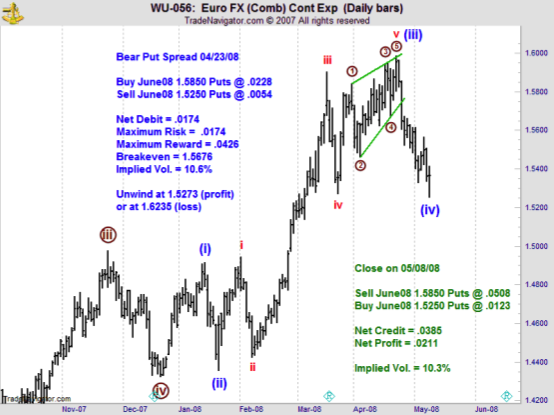
Figure 13
In Figure 13, we flash forward to see how the trade unfolded. The fifth-wave ending diagonal did indeed deliver a swift reversal (recall Figure 6). And, as you can see, we reached our target of $1.5273 on May 8th. From a risk point of view, there is no reason to stay in this position so we’re going to unwind the trade and close out on May 8th. We’ll sell the June $1.5850 puts at .0508; we’ll buy back the $1.5250 puts at .0123. We get a net credit of 385 points and a net profit of 211 points. Implied volatility did not change much — it was 10.3% (versus 10.6% on April 23), so that worked in our favor. The “secret” to the trade’s success was its adherence to the ideal wave characteristics of a bear put spread strategy as identified in Figure 3. It was a countertrend move in a fourth wave of low degree (Minuette). We entered early. And, most importantly, the key to setting up everything was identifying that we had a fifth-wave ending diagonal in the prior wave at the next lower degree. As we know, this pattern implies a dramatic reversal ahead.
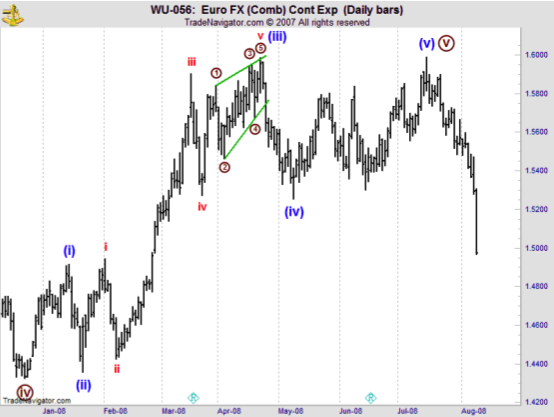
Figure 14
So, we got out on May 8th, but the contract didn’t expire until June 6th. In Figure 14, you can see that our choice to exit early was the right one in order to satisfy the risk/reward ratio. We made a slight new high in Minuette wave (v) at $1.5988. (The previous high in Minuette wave (iii) was $1.5985.) This move unfolded as another fifth-wave ending diagonal, which, sure enough, was followed by a swift and sharp reversal to the downside.
Mole here again: Alright, this completes chapter 1 – congrats if you made it all the way to down here. If you have questions, ideas, contributions – then please post them below in the comment section. We will continue this series next week with the introduction of the Bull Call Ladder and Bear Put Ladder – fun stuff!
See you on Sunday.
Cheers,
Mole
















